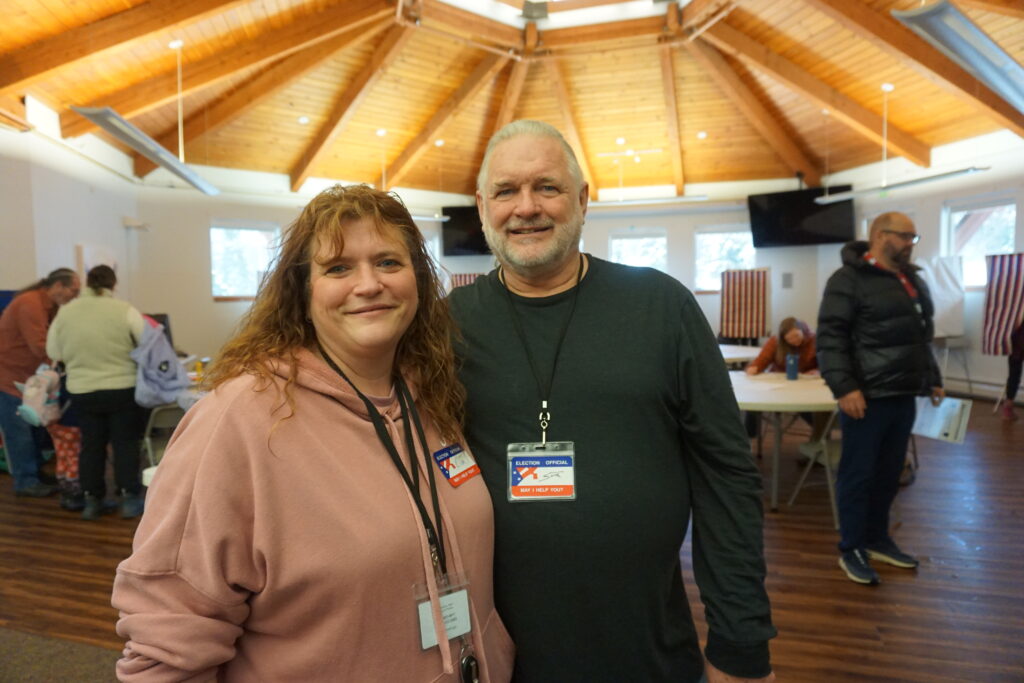![]()
Kim Lundemo, chair for Precinct 11-220, and Scott Williamson, chair for Precinct 11-225, pose on Tuesday in the Alaska Zoo room where voters from both districts in Anchorage’s Lower Hillside area cast their ballots. The Alaska Zoo is regularly used as a polling site, but it is one of the more unusual places in the state where people cast votes. (Photo by Yereth Rosen/Alaska Beacon)
In a corner of South Anchorage, voters are casting their ballots at the home of some moose, bears, seals, caribou and numerous other animals of the north.
The Alaska Zoo, a haven for injured or orphaned animals that cannot return to the wild, is a regular polling place for two precincts in the Lower Hillside area. Among the schools, fire stations, community halls and other sites converted into polling stations, the zoo stands out as an especially interesting place to cast votes.
In a large and airy upstairs room in the zoo administration building, the left half was devoted to precinct 11-220, while the right half was for voters in precinct 11-225.
Turnout was strong from the beginning of the day, said Scott Williamson, chair for precinct 11-225.
“We had a line all around the parking lot at 7 o’clock,” he said, speaking at midmorning, as voters streamed in and out.

Every election, there are people who vote and then pop over to the zoo to visit the animals, especially if they are parents with young children in tow, said Williamson, who has been the precinct chair since 2006.
But he and colleague Kim Lundemo, the chair for the precinct on the other side of the room, do not have that luxury, he said. They were expecting to be working well past the zoo’s closing time. “Being the chair down here, sometimes it’s 11 o’clock at night,” he said.
Another unusual Alaska polling site is Ursa Major Distilling in the Fairbanks North Star Borough community of Ester, which two years ago replaced the Ester fire station as the place to cast votes. On most days, the distillery is a gathering site for connoisseur of handcrafted alcoholic beverages, including gin, rum, and an Alaska version of Akvavit, an herb-flavored Scandinavian spirit.
On Election Day, however, there are no alcohol sales. Instead, tables are pushed aside to make room for voting booths and other equipment and gear needed to allow locals to cast ballots.
In Shungnak, a Northwest Arctic Borough community on the Kobuk River, the designated polling place is a local coffee house, according to the Alaska Division of Elections. The Shungnak Coffee House has also served as a local elections polling site in the mostly Inupiat community.

Some sports and recreation sites have also been pressed into service as polling spots. The ski chalet at the Government Peak Recreation Area is the site to cast votes in one Palmer precinct. Other examples are in Ketchikan, where the borough-operated Gateway Recreation Center serves that purpose, and in Midtown Anchorage, where the YMCA is a polling site.
Of all the unusual polling sites, the Alaska Zoo might be the one has the closest relationship to election seasons.
During the runups to state and national elections, the zoo conducts its own elections to select the animal who will be designated as the facility’s “president.”
This year, there are three tickets vying. One is presidential candidate Kova, a polar bear, with vice presidential candidate Atari, a raven. Another is presidential candidate Little Rock, a muskox, with running mate Fluffy Matt, an alpaca. The third ticket is that of presidential candidate Fred, a river otter, and running mate Finn, a mountain goat.
Like the state and federal elections, voting was to conclude Tuesday, with results announced shortly after the end of the business day. Unlike the state and federal elections, the zoo election allows multiple votes. Each vote requires a donation, with proceeds going to the zoo’s general fund.

YOU MAKE OUR WORK POSSIBLE.

